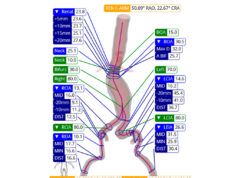
A recent study comparing outcomes of endovascular aneurysm repair (EVAR) patients has reported no statistically significant differences in mortality or secondary rupture rates between standard Cook, Medtronic and Gore endografts, suggesting similar safety in a real-world setting.
Michael O Falster (Centre for Big Data Research in Health, Sydney, Australia), Ramon L Varcoe (Prince of Wales Hospital, Sydney, Australia) and colleagues report this and other outcomes from a large population-based observational study in the European Journal of Vascular and Endovascular Surgery (EJVES).
Another key finding was that rates of subsequent aneurysm repair were higher for endografts other than Cook devices, but only statistically significant for Medtronic devices.
In order to compare rates of all cause death, secondary rupture and secondary intervention in their retrospective cohort study, Falster, Varcoe et al used linked clinical registry (Australasian Vascular Audit [AVA]) and all payer administrative data from patients undergoing EVAR for intact abdominal aortic aneurysm (AAA) between 2010 and 2019 in New South Wales, Australia.
The authors identified 2,874 eligible EVAR patients, with a median follow-up of 4.1 years and a maximum follow-up of 9.5 years.
Writing in EJVES, Falster, Varcoe and colleagues report similar mortality rates for patients receiving different devices, ranging between 7 and 7.3 per 100 person years. In addition, they reveal that there was no statistically significant difference between devices in secondary rupture rates, which ranged between 0.4 and 0.5 per 100 person years.
Furthermore, Falster, Varcoe et al note that patients receiving Medtronic and Gore devices tended to have higher crude rates of subsequent aneurysm repair (1.5 per 100 person years) than patients receiving Cook devices (0.8 per 100 person years). This finding, the authors write, remained in the adjusted analysis, but was only statistically significant for Medtronic devices (hazard ratio [HR] 1.57, 95% confidence interval [CI] 1.02–2.47; HR 1.73, 95% CI 0.94–3.18, respectively).
“Major endograft devices have similar overall long-term safety profiles,” the authors summarise in their concluding statement. However, they add, there may be differences in rates of secondary intervention for some devices. “This may reflect endograft durability, or patient selection for different devices based on aneurysm anatomy,” Falster, Varcoe and colleagues posit.
According to the authors, this population-based study is one of the largest to compare outcomes of EVAR patients receiving contemporary endografts from different manufacturers.
In the discussion of their findings, the investigators note that there are no studies that have randomised patients to endograft type to evaluate long-term mortality and secondary intervention rates. Given this absence, Falster, Varcoe et al suggest, observational studies “have a place” in providing “complementary” evidence for postmarket outcomes and are “well positioned to address the evidence gap around emerging technologies”.
The key strength of the present study, the authors claim, was the use of linked clinical registry and population-level administrative data. “This study is one of the largest to have explored outcomes for patients receiving different endografts, and also one of the only studies to have examined a contemporary cohort of patients to directly compare outcomes of endografts in current use,” Falster, Varcoe et al add.
The authors underscore “a need for ongoing surveillance of patient outcomes to compare and evaluate different devices used in clinical practice” to ensure those grafts are “providing the highest levels of safety and efficacy, with identification of those that are not”. Falster, Varcoe and colleagues opine that the history of endovascular surgery is “littered with examples of underperforming endografts,” which after evaluation were “identified and managed by either temporary pause for device modification or withdrawal from the commercial market entirely”.
The investigators stress that regulators such as the US Food and Drug Administration are “acutely aware” of the importance of postmarket data to assess the safety of device and encourage surveillance programmes. The present study, Falster, Varcoe et al claim, “demonstrates that linkage of clinical registry and administrative data can strengthen the evidence to help fill the inevitable gaps which occur when [randomised controlled trials] do not exist or are unethical to perform”. They continue: “Increased capacity within clinical registries to identify specific endograft devices, as well as indication for device choice, will further enable this comparative work.”
Considering the limitations of their work, Falster, Varcoe and colleagues note that the drawbacks of administrative data are “well known,” referencing the fact that the present linkage rate of 82.7% between the AVA and administrative datasets means that findings “may not be representative of all EVAR patients in [New South Wales]”.
The investigators stress that their results must be “interpreted with some caution” given the small number of patients receiving some endografts, the relative scarcity of some of the endpoints (e.g. aneurysm rupture) and that the bias which may result from individual surgeons’ subjective device selection methods and the potential for unmeasured confounders has not been eliminated from the study.
“Continuous comparative assessments are needed to guide evidence for treatment decisions across the range of available devices,” Falster, Varcoe et al write in their closing remarks.













